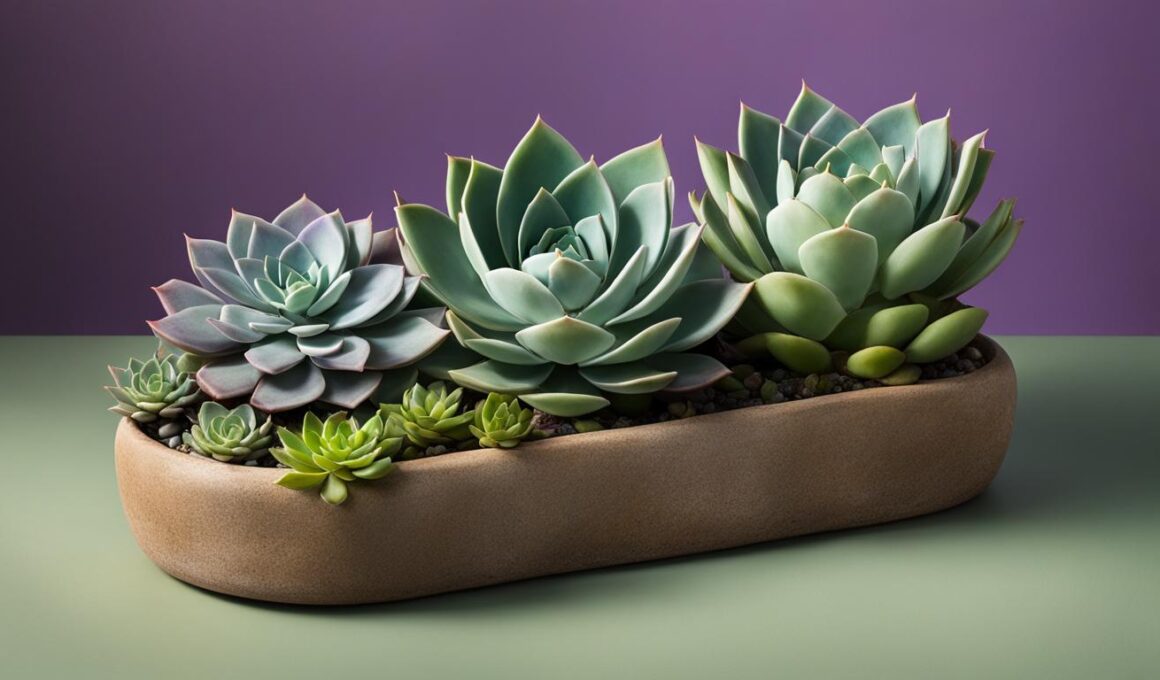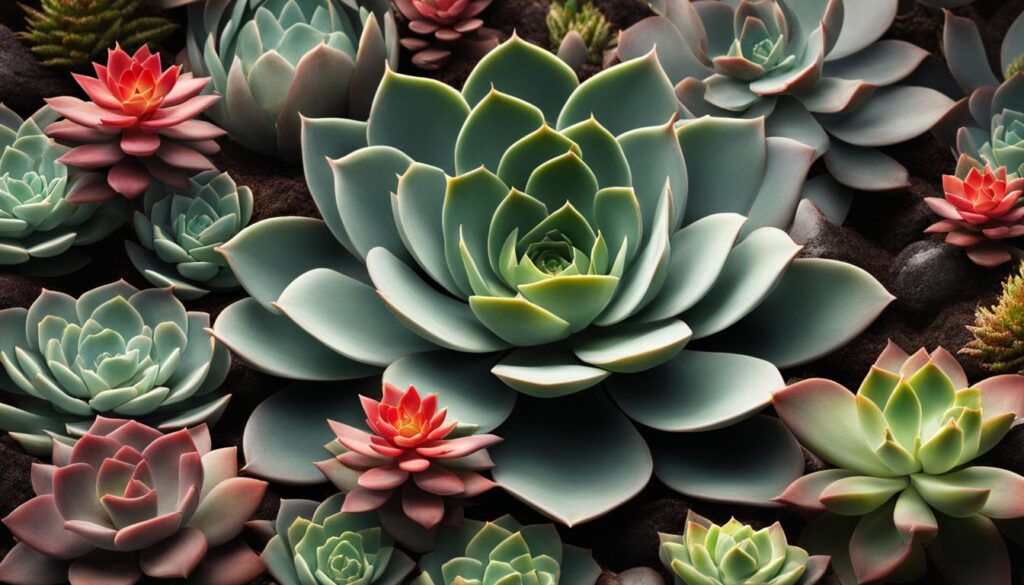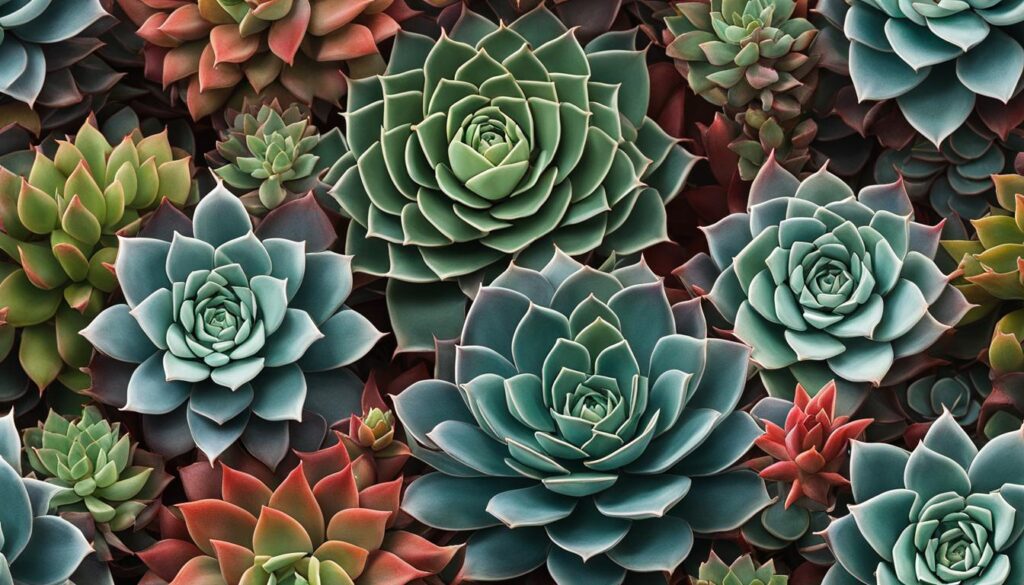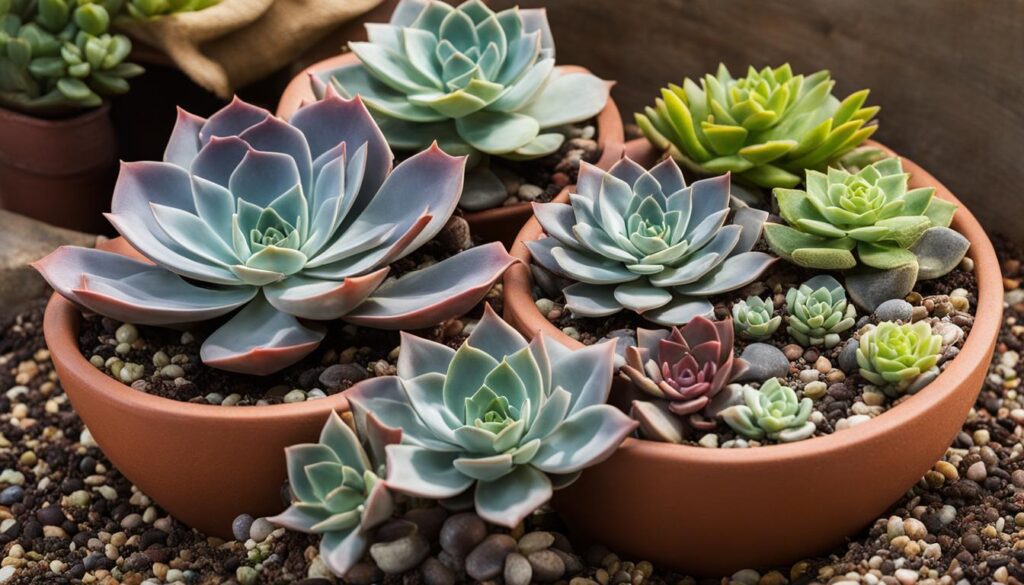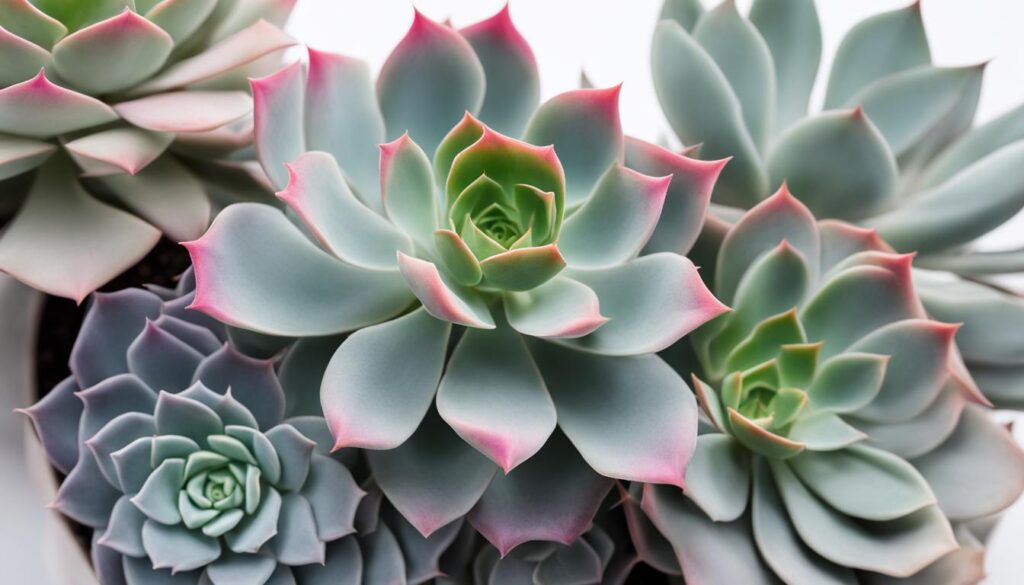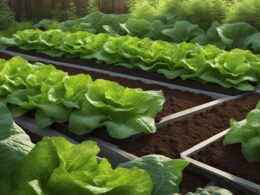Echeveria and Graptopetalum are two popular types of succulents that are often confused with each other due to their similarities. However, with a closer look at their characteristics, you can easily distinguish between the two.
Both types of succulents have rosette-shaped structures and can thrive in desert environments. However, Echeveria is best identified by its rosettes on short stalks and spoon-shaped leaves, while Graptopetalum is best identified by its trailing vines of rosettes on long stalks and stems. In addition, the leaves of Echeveria can come in a wide range of colors, while the leaves of Graptopetalum are usually green, gray, or gray-white. By examining the leaf shape, color, and texture, as well as the growth pattern and flower shape, you can easily tell Echeveria and Graptopetalum apart.
Post Summary
- Echeveria and Graptopetalum are two types of succulents that are often mistaken for each other due to their similarities.
- Echeveria is characterized by its rosettes on short stalks and spoon-shaped leaves, while Graptopetalum has trailing vines of rosettes on long stalks and stems.
- Echeveria leaves come in a wide range of colors, while Graptopetalum leaves are usually green, gray, or gray-white.
- Examining the leaf shape, color, texture, growth patterns, and flower shape can help you differentiate between Echeveria and Graptopetalum.
- Echeveria and Graptopetalum have similar care requirements, including full sun, well-draining soil, and infrequent watering.
Origin and Habitat
Echeveria and Graptopetalum, two popular types of succulents, have their origins in the Americas. Echeveria is primarily found in Mexico, Central America, and northwestern South America, while Graptopetalum is native to Mexico and the American Southwest.
Both succulents are well-adapted to desert environments but can also survive in colder and moister climates. Understanding their native habitats provides insights into their care requirements. Echeveria thrives in full sun and well-draining soil, while Graptopetalum can tolerate some shade and requires similar soil conditions.
Echeveria Habitat:
- Origin: Mexico, Central America, and northwestern South America
- Preferred Climate: Desert environments
- Light Requirements: Full sun
- Soil Requirements: Well-draining soil
Graptopetalum Habitat:
- Origin: Mexico and the American Southwest
- Preferred Climate: Desert environments, but can tolerate some shade
- Light Requirements: Full sun to partial shade
- Soil Requirements: Well-draining soil
Comparison of Echeveria and Graptopetalum Habitats
| Echeveria | Graptopetalum |
|---|---|
| Origin: Mexico, Central America, and northwestern South America | Origin: Mexico and the American Southwest |
| Preferred Climate: Desert environments | Preferred Climate: Desert environments, but can tolerate some shade |
| Light Requirements: Full sun | Light Requirements: Full sun to partial shade |
| Soil Requirements: Well-draining soil | Soil Requirements: Well-draining soil |
Echeveria Vs Graptopetalum: A Detailed Comparison of Leaf Characteristics
When it comes to distinguishing between Echeveria and Graptopetalum, one of the key factors to consider is their leaf characteristics.
Echeveria leaves are spoon-shaped with smooth edges and sometimes a pointed tip. These leaves come in a wide range of vibrant colors, including blue, gray, silver, yellowish-pink, and even red. The smooth texture of Echeveria leaves adds to their aesthetic appeal.
On the other hand, Graptopetalum leaves are usually thicker and have a triangular or rounded tip. They are more commonly seen in shades of green, gray, or gray-white. One distinctive feature of Graptopetalum leaves is the presence of a white, powdery substance called pruinose, which gives them a unique gray-white appearance.
Echeveria Leaves
| Leaf Shape | Leaf Color | Leaf Texture |
|---|---|---|
| Spoon-shaped | Blue, gray, silver, yellowish-pink, red | Smooth |
Graptopetalum Leaves
| Leaf Shape | Leaf Color | Leaf Texture |
|---|---|---|
| Triangular or rounded | Green, gray, gray-white | Powdery (pruinose) |
By examining the shape, color, and texture of the leaves, you can easily differentiate between Echeveria and Graptopetalum. Whether it’s the vibrant hues of Echeveria or the unique pruinose coating on Graptopetalum, the leaves of these succulents offer a fascinating array of colors and textures.
Stem and Growth Pattern
Another distinguishing feature between Echeveria and Graptopetalum is their stem and growth pattern. Understanding the growth patterns of these succulents can aid in their identification.
Echeveria typically has short stalks and grows in a compact rosette shape. In some cases, Echeveria may develop long stems, but these stems grow vertically. On the other hand, Graptopetalum has trailing vines of rosettes that grow on long stalks and stems. The stems of Graptopetalum can hang down over the edges of pots or spread along the ground if grown in the ground.
To further illustrate the differences, refer to the table below:
| Succulent | Stem | Growth Pattern |
|---|---|---|
| Echeveria | Short stalks, sometimes long vertical stems | Compact rosette shape |
| Graptopetalum | Long stalks and trailing vines | Trailing or spreading growth |
By referring to the table and observing the stem and growth pattern of a succulent, you can distinguish between Echeveria and Graptopetalum. This information can be valuable when identifying and caring for these unique succulents.
Echeveria Vs Graptopetalum: A Detailed Comparison of Succulent Flowers
When it comes to identifying Echeveria and Graptopetalum, their distinct flower characteristics play a crucial role. By closely examining their flower shapes, colors, and blooming patterns, you can easily differentiate between these two popular succulents.
Echeveria flowers are known for their charming bell shape, adding elegance to the overall appearance of the plant. These bell-shaped flowers can range in colors from vibrant shades of orange, pink, and red to delicate hues of white and yellow. The variety of colors adds to the allure of Echeveria, making it a favorite among succulent enthusiasts.
In contrast, Graptopetalum flowers sport a unique star shape, which sets them apart from Echeveria. These star-shaped blooms also come in a diverse range of colors, including white, pink, and yellow. The star shape gives Graptopetalum flowers a distinct and eye-catching look, enhancing the visual appeal of the plant.
Observing the flower characteristics of Echeveria and Graptopetalum can provide valuable insights into identifying these succulents correctly. Whether it’s the bell-shaped flowers of Echeveria or the star-shaped blossoms of Graptopetalum, their distinctive floral features add beauty and charm to any succulent collection.
Echeveria Vs Graptopetalum – Flower Characteristics
| Succulent | Flower Shape | Flower Colors |
|---|---|---|
| Echeveria | Bell-shaped | Orange, pink, red, white, yellow |
| Graptopetalum | Star-shaped | White, pink, yellow |
Echeveria Vs Graptopetalum: A Detailed Comparison of Rosette Size
When it comes to Echeveria and Graptopetalum, one key difference that sets them apart is the size of their rosettes. The rosettes of Echeveria can vary greatly in diameter, ranging from as small as ¾ inches to as large as 20 inches. On the other hand, Graptopetalum rosettes typically range from 2 to 5 inches in diameter. While size alone may not be a definitive factor in identifying these succulents, it can provide a clue. If you come across a rosette that is smaller than 2 inches or larger than 5 inches, there’s a good chance it’s an Echeveria.
To give you a better visual representation of the rosette sizes of Echeveria and Graptopetalum, take a look at the table below:
| Succulent | Minimum Rosette Diameter (in inches) | Maximum Rosette Diameter (in inches) |
|---|---|---|
| Echeveria | ¾ | 20 |
| Graptopetalum | 2 | 5 |
As you can see, Echeveria rosettes can be significantly larger than those of Graptopetalum. However, keep in mind that there may be some variation within each species, and individual plants can have slightly different rosette sizes.
Understanding the differences in rosette size between Echeveria and Graptopetalum can be a helpful tool in identifying these succulents and adding to your overall knowledge of their unique characteristics.
Succulent Hybridization: The Creation of x Graptoveria
One fascinating aspect of succulents is their ability to cross-pollinate and create hybrid plants with unique characteristics. Echeveria and Graptopetalum, two closely related succulents, can be hybridized to produce a new type of succulent known as x Graptoveria. These hybrids combine traits from both parent plants, resulting in a wide range of stunning colors, leaf shapes, and growth habits.
Hybridization between Echeveria and Graptopetalum occurs naturally through cross-pollination by insects or can be intentionally done by succulent enthusiasts and breeders. The resulting offspring, x Graptoveria, inherits the rosette shape and compact growth pattern of Echeveria, as well as the trailing habit and long stalks of Graptopetalum. This combination results in a visually striking succulent that showcases the best of both parent plants.
The x Graptoveria hybrids can vary greatly in appearance, with different color combinations and patterns on their leaves. Some popular varieties include ‘Fred Ives’ with its rosettes of pinkish-lavender leaves, ‘Debbie’ with its blue-green leaves tinged with pink, and ‘Ghost Plant’ with its pale gray leaves. These hybrids have gained popularity among succulent enthusiasts and collectors due to their unique and visually appealing characteristics.
It’s important to note that hybridization between Echeveria and Graptopetalum can occur naturally in the wild or through controlled breeding efforts. As a result, there may be variations in the appearance and characteristics of x Graptoveria hybrids. These variations contribute to the diversity and allure of these hybrid succulents, making them a fascinating subject for succulent enthusiasts to explore and appreciate.
Echeveria and Graptopetalum Care: Tips for Growing Succulents
When it comes to caring for Echeveria and Graptopetalum, these two succulents have similar requirements. Both thrive in full sun and well-draining soil, making them ideal for gardens or containers in sunny locations. However, there are a few key differences to consider when it comes to their care.
Echeveria prefers infrequent watering, allowing the soil to dry out between waterings. Overwatering can lead to root rot, so it’s important to err on the side of underwatering. On the other hand, Graptopetalum can tolerate slightly more water and is more forgiving if you accidentally overwater. However, like all succulents, both Echeveria and Graptopetalum dislike being constantly wet, so it’s important to strike a balance.
In terms of temperature, both succulents are not frost-hardy and prefer moderate to warm temperatures. Echeveria may suffer damage if exposed to prolonged frost or freezing temperatures, so it’s best to bring them indoors or provide protection during winter. Graptopetalum, however, tends to be a bit more tolerant of cooler temperatures and can withstand light frost.
Pest and Disease Control
Like any plant, Echeveria and Graptopetalum are susceptible to pests and diseases. The most common pests that can affect succulents include mealybugs, aphids, and scale insects. To control these pests, you can use insecticidal soap or neem oil, applying them according to the instructions on the product. It’s also important to regularly inspect your plants for signs of infestation and take action promptly.
In terms of diseases, overwatering can lead to root rot, which can be fatal if not addressed. To prevent this, ensure that your succulents are planted in well-draining soil and that any excess water drains away. Additionally, proper air circulation can help prevent fungal diseases, so avoid overcrowding your plants and provide adequate spacing between them.
Echeveria and Graptopetalum Care Comparison
| Aspect | Echeveria | Graptopetalum |
|---|---|---|
| Watering | Infrequent waterings, allowing the soil to dry out between waterings | Slightly more tolerant of water, but still prefers infrequent waterings |
| Temperature | Not frost-hardy, protect from freezing temperatures | More tolerant of cooler temperatures, can withstand light frost |
| Pest Control | Susceptible to mealybugs, aphids, and scale insects | Susceptible to mealybugs, aphids, and scale insects |
| Disease Control | Overwatering can lead to root rot | Overwatering can lead to root rot |
By following these care tips, you can ensure the health and vibrancy of your Echeveria and Graptopetalum. Remember to provide them with the right amount of sunlight, well-draining soil, and infrequent watering. With proper care, these succulents will flourish and add beauty to your home or garden.
Identifying Photos
If you’re still uncertain about the identification of a succulent, clear photos can provide additional guidance. Comparing your plant’s characteristics with those in photos can help you determine whether it is an Echeveria or a Graptopetalum. Below are some common features to look for:
- Leaf Shape: Echeveria leaves are spoon-shaped, while Graptopetalum leaves are usually thicker with a triangular or rounded tip.
- Leaf Color: Echeveria leaves come in a wide range of colors, including blue, gray, silver, yellowish-pink, and red, while Graptopetalum leaves are often green, gray, or gray-white.
- Growth Pattern: Echeveria typically grows in a compact rosette shape on short stalks, while Graptopetalum has trailing vines of rosettes on long stalks and stems.
- Flower Shape: Echeveria flowers have a bell shape, while Graptopetalum flowers have a star shape.
- Rosette Size: Echeveria rosettes can range from small to large, while Graptopetalum rosettes are generally smaller in size.
By examining these characteristics in photos, you can gain a better understanding of whether your succulent is an Echeveria or a Graptopetalum. You can find galleries of Echeveria and Graptopetalum photos online to aid in your identification process. These galleries may also provide additional care tips for growing these succulents at home.
Identifying Echeveria and Graptopetalum Succulents
| Feature | Echeveria | Graptopetalum |
|---|---|---|
| Leaf Shape | Spoon-shaped | Thicker with triangular or rounded tip |
| Leaf Color | Wide range of colors | Green, gray, or gray-white |
| Growth Pattern | Compact rosettes on short stalks | Trailing vines of rosettes on long stalks and stems |
| Flower Shape | Bell-shaped | Star-shaped |
| Rosette Size | Varying sizes | Smaller rosettes |
By comparing these distinct features, you can confidently identify whether your succulent is an Echeveria or a Graptopetalum. Remember to consider multiple characteristics, as some succulents can exhibit overlapping traits. Using photos and tables as references can be a valuable tool in deciphering the identity of your succulent.
Developing Succulent Identification Skills
Identifying succulents can be a challenging task, especially for beginners. However, by developing your succulent identification skills, you can become more confident in distinguishing between different types of succulents. Here are some expert tips to help you sharpen your identification abilities:
1. Study Succulent Characteristics
Take the time to study the unique characteristics of different succulent varieties. Focus on leaf shape, color, texture, growth pattern, and flower shape. Familiarize yourself with common succulent species and their distinct features. Observing and comparing these characteristics will train your eye to spot the subtle differences between succulents.
2. Utilize Visual Resources
Visual resources such as online photo galleries and succulent identification guides can be valuable tools in improving your identification skills. These resources provide clear images of various succulent varieties, allowing you to compare and match the characteristics of your own plants with those in the photos. By visually analyzing the details, you can make more accurate identifications.
3. Seek Guidance from Experienced Gardeners
Connecting with experienced gardeners or joining succulent enthusiast communities can provide valuable insights and guidance. Engaging in discussions and asking specific questions about succulent identification can help you gain knowledge from those with experience. Their expertise and personal anecdotes can enhance your understanding of the nuances in identifying different succulent species.
4. Practice at Local Nurseries
Visit local nurseries or botanical gardens to practice your identification skills. Examine the variety of succulents on display and try to identify them based on their distinguishing characteristics. Take note of any unfamiliar plants and later compare them to reference resources. This hands-on experience will train your eye and improve your ability to identify succulents accurately.
Remember, developing succulent identification skills takes time and practice. Stay curious and persistent, and don’t be discouraged by occasional mistakes. Each identification challenge is an opportunity to learn and grow as a succulent enthusiast. With time and experience, you’ll become an expert at distinguishing between different succulent varieties.
Conclusion
In conclusion, the comparison between Echeveria and Graptopetalum highlights their distinct characteristics. By examining their leaf shape, color, and texture, as well as their growth patterns, flower shapes, and rosette sizes, you can easily differentiate between these two popular succulents. The leaves of Echeveria are spoon-shaped and come in a variety of colors, while Graptopetalum leaves are thicker and have a gray-white appearance due to the pruinose coating. Echeveria typically grows in compact rosettes on short stalks, whereas Graptopetalum forms trailing vines of rosettes on long stalks and stems.
While Echeveria and Graptopetalum share similar care requirements, such as full sun exposure, well-draining soil, and infrequent watering, it is important to note that Graptopetalum tends to tolerate shade better. Understanding their respective native habitats can also provide insights into their care needs.
It’s worth mentioning that hybrid succulents called x Graptoveria can further complicate the identification process, as they combine traits from both Echeveria and Graptopetalum. However, by familiarizing yourself with the unique characteristics of each succulent and utilizing visual resources for identification, you can appreciate the diversity and beauty of these plants.
Which Succulent is Better for Indoor Gardening, Echeveria or Graptopetalum?
When it comes to indoor gardening, deciding between Echeveria and Graptopetalum can be challenging. This haworthia fasciata comparison guide can help. Echeveria is known for its rosette-shaped leaves and vibrant colors, while Graptopetalum features stacked, geometric leaves. Consider your indoor space and light conditions to choose the best succulent for your needs.
FAQ
How can I tell the difference between Echeveria and Graptopetalum?
You can distinguish between Echeveria and Graptopetalum by examining their leaf shape, color, and texture, as well as their growth pattern, flower shape, and rosette size.
What are the native habitats of Echeveria and Graptopetalum?
Echeveria is mainly found in Mexico, Central America, and northwestern South America, while Graptopetalum is primarily found in Mexico and the American Southwest.
How do the leaves of Echeveria and Graptopetalum differ?
The leaves of Echeveria are spoon-shaped, come in a wide range of colors, and have a smooth texture. Graptopetalum leaves are usually thicker, green, gray, or gray-white in color, and are coated with a white, powdery substance called pruinose.
What is the growth pattern of Echeveria and Graptopetalum?
Echeveria typically has short stalks and grows in a compact rosette shape. Graptopetalum has trailing vines of rosettes that grow on long stalks and stems.
How do the flowers of Echeveria and Graptopetalum differ?
Echeveria flowers have a bell shape, while Graptopetalum flowers have a star shape. Both types of flowers can come in various colors.
How big are the rosettes of Echeveria and Graptopetalum?
Echeveria rosettes can range from as small as ¾ inches to as large as 20 inches in diameter. Graptopetalum rosettes typically range from 2 to 5 inches in diameter.
Can Echeveria and Graptopetalum be cross-pollinated to create hybrids?
Yes, Echeveria and Graptopetalum can be cross-pollinated to create hybrid succulents called x Graptoveria, which combine traits of both parent plants.
What are the care requirements for Echeveria and Graptopetalum?
Both succulents thrive in full sun and well-draining soil, prefer infrequent watering, and are not frost-hardy. Graptopetalum tends to tolerate shade better than Echeveria.
How can I identify Echeveria and Graptopetalum through photos?
Clear photos can be compared with online galleries to identify the characteristics of Echeveria and Graptopetalum. Some galleries may also provide care tips for these succulents.
How can I develop my succulent identification skills?
Developing succulent identification skills involves honing observation abilities, familiarizing oneself with various succulent characteristics, practicing identification at local nurseries, and seeking guidance from experienced gardeners.





